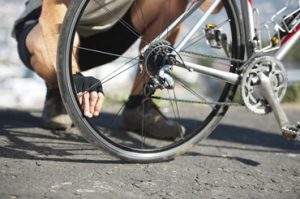Cycling Safety

While many associate Seattle with coffee, rain or seafood, many Seattleites see the relationship between the city and cycling to be stronger.
With the start of summer behind us and a refreshing shift in typical summer weather patterns, the increase of cyclists on the road is evident. As more hit the road either for leisure, work or competitive purposes, it’s important to practice safe cycling methods to prevent injury.
The common injuries associated with cycling are usually due to overuse and improper bike fit. Common injuries can include knee pain, hand pain and numbness, neck or back strain and foot numbness or tingling. If pain starts to occur in one of these areas, resting, icing the area and checking the bike fit would be a good start. However, if the condition persists, consult your physician.
The right equipment
Having your bike properly fitted and fully maintained (e.g., gears shift smoothly, tires are inflated adequately and the chain is oiled versus rusted) is essential.
Poor posture on the bike can strain and cause pain in multiple areas, including the back, neck, shoulders and arms. A good bike fit helps with a cyclist’s ergonomics and can help minimize injuries related to poor posture/positioning. It can also help maximize your power while simultaneously minimizing fatigue.
If you’re uncertain how to ensure you’re doing everything correctly, ask for help at a local bike shop — they’re always willing to help out a fellow cyclist.
Always wear a helmet! Wearing a helmet can help prevent and minimize head injuries. A helmet should fit snugly and cover the top of your forehead. If it is tilting back like a bonnet, your brain is not protected and you need to try something else.
The straps should fit comfortably close to your face and chin, not dangling loosely as that will not help should an accident occur. A helmet is critical to your safety and health; spend time ensuring a good fit.
Train accordingly
During the summer, it is easy to turn a simple bike ride into an all-day adventure. It is encouraged to gradually build up to a race or long-distance stamina to avoid injury.
Start with a short ride and then add a few miles each time, building up to the full distance. This is especially important for those training for a ride like the Seattle to Portland Bicycle Classic. A sudden increase in training, high-intensity exercise or excessive knee bending can put excess pressure on the joints and lead to knee pain and tendonitis. Training beforehand makes certain you will enjoy the event more and feel better afterward.
Choose variety
Biking every day can overexert certain muscles. Varying your exercises can help strengthen other muscles that you don’t use while biking. Cross-training with exercises like yoga, weight lifting, running, etc., are great alternative methods. This will help prevent injury in the long run.
With any exercise comes risk of injury. But by using proper preventative care, the chances are less likely and the joy experienced is greater. Following these precautions will help make sure you and your bike are ready for a safe, fun summer. Now get out and enjoy the roads.



